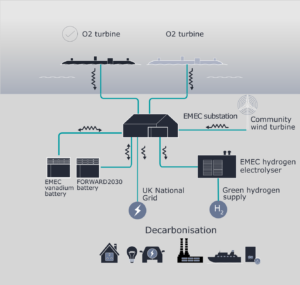ENGIE Laborelec is partnering in FORWARD2030, an EC-funded project aiming to demonstrate the viability of a zero-carbon energy system which combines wind and tidal energy with energy storage solutions and green hydrogen production.
Running from 2021 to 2025, the FORWARD2030 project consortium has received €21.5 millions of grant support from the European Union’s Horizon 2020 research and innovation programme. Its goal is to develop a multi-vector energy system for the future and demonstrate how predictable tidal energy, wind energy, energy storage technologies, and green hydrogen production can be combined in a smart way so that a reliable and stable zero-carbon baseload can be injected into the grid.
The project also looks at reducing the cost and life-cycle carbon footprint associated with offshore tidal energy, making it more environmentally sound and achieving better public acceptance, while improving commercial return and system integration. Some of these conclusions will be extrapolated to offshore energy. ENGIE Laborelec brings to the project its expertise in combining different types of renewable energy with energy storage systems and grid integration.
A multi-vector energy system
The system combines predictable floating tidal energy, wind generation, battery storage, green hydrogen production and grid export.
Preliminary investigations and analysis
The project is currently at the preliminary investigation stage, with the first challenge being to define, size and purchase the most suitable power storage solution to be installed at the project site in Orkney, Scotland (EMEC). We’re gathering information on the site layout, profile, and set-up, as well as energy data on existing tidal power production and specifications for additional wind and tidal systems.
Wide range of scenarios evaluated
Various scenarios can then be developed combining these renewable power generation systems with a range of power storage solutions as well as the existing redox-flow batteries and hydrogen fuel cells. “We’ll be looking at the viability of combining different solutions, together with complicating factors such as ramp-up times and sensitivity to temperature fluctuations,” says Laborelec expert Fiona Buckley. “It means we’ll be deploying the full potential of our inhouse expertise.”
